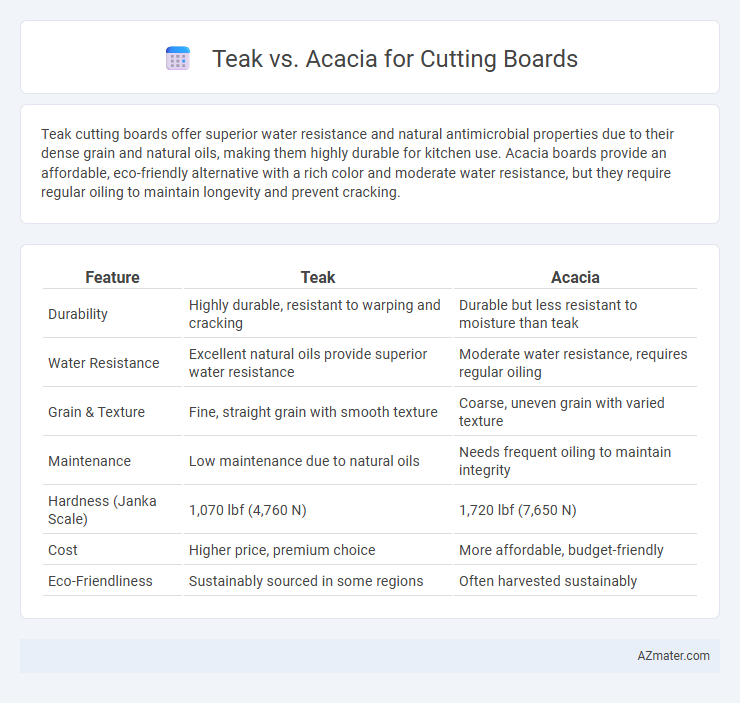Teak cutting boards offer superior water resistance and natural antimicrobial properties due to their dense grain and natural oils, making them highly durable for kitchen use. Acacia boards provide an affordable, eco-friendly alternative with a rich color and moderate water resistance, but they require regular oiling to maintain longevity and prevent cracking.
Table of Comparison
| Feature | Teak | Acacia |
|---|---|---|
| Durability | Highly durable, resistant to warping and cracking | Durable but less resistant to moisture than teak |
| Water Resistance | Excellent natural oils provide superior water resistance | Moderate water resistance, requires regular oiling |
| Grain & Texture | Fine, straight grain with smooth texture | Coarse, uneven grain with varied texture |
| Maintenance | Low maintenance due to natural oils | Needs frequent oiling to maintain integrity |
| Hardness (Janka Scale) | 1,070 lbf (4,760 N) | 1,720 lbf (7,650 N) |
| Cost | Higher price, premium choice | More affordable, budget-friendly |
| Eco-Friendliness | Sustainably sourced in some regions | Often harvested sustainably |
Teak vs Acacia for Cutting Boards: An Overview
Teak cutting boards are prized for their natural oil content, providing superior water resistance and durability, which reduces the risk of cracking and warping over time. Acacia boards offer a dense, hard surface with a rich, warm color but require more frequent oiling to maintain moisture resistance and prevent splitting. Both woods are sustainable options, yet teak's inherent oils make it a more low-maintenance choice for long-lasting cutting boards.
Durability Comparison: Teak vs Acacia
Teak cutting boards exhibit superior durability due to their high oil content, natural resistance to water, and dense grain structure that resists warping and cracking over time. Acacia boards are also durable with a strong, dense hardwood composition, but they require more maintenance to prevent drying and splitting because they lack the same natural oils as teak. Both woods offer excellent durability for cutting boards, but teak's inherent moisture resistance gives it a longer lifespan and better performance under frequent use.
Water Resistance and Maintenance
Teak boasts superior water resistance due to its natural oils, making it highly durable and less prone to warping or cracking in wet conditions compared to acacia. Acacia cutting boards require more frequent oiling to maintain their water resistance and prevent drying out or splitting over time. Both woods benefit from regular maintenance, but teak's dense grain and natural oils reduce the need for constant upkeep, ensuring longer-lasting protection against moisture.
Hardness and Knife Friendliness
Teak cutting boards offer a Janka hardness of approximately 1,155, making them moderately hard and highly durable while maintaining knife friendliness due to their natural oils that help prevent blade dulling. Acacia wood scores slightly lower on the Janka scale at around 1,070, providing a good balance of hardness and resistance to wear, but it is slightly less forgiving on knives compared to teak because it lacks similar oil content. Both woods are excellent for cutting boards, but teak's hardness combined with its self-oiling properties makes it a superior choice for preserving knife edges over time.
Aesthetic Appeal: Grain and Color Differences
Teak cutting boards feature a rich, golden-brown hue with a straight, fine grain that deepens over time, offering a warm and luxurious aesthetic. Acacia boards display a more varied palette, ranging from light amber to dark brown, with a distinctive, irregular grain pattern that adds a rustic charm. The contrasting grain complexity and color tones make teak boards ideal for a sleek, modern kitchen, while acacia complements a more natural, eclectic style.
Sustainability and Environmental Impact
Teak cutting boards are highly sustainable due to teak's fast growth and natural oil resistance, which reduces the need for chemical treatments and extends board lifespan. Acacia wood is also eco-friendly, sourced from fast-growing hardwood trees that regenerate quickly, making it a renewable resource with minimal deforestation impact. Both woods offer durability, but teak's natural resistance to moisture and pests enhances its environmental benefits by decreasing replacement frequency and maintenance resources.
Cost and Value for Money
Teak cutting boards typically cost more due to their high natural oil content and exceptional durability, which resists moisture and prevents warping. Acacia boards are generally more affordable, offering good hardness and resistance to knife marks, making them a budget-friendly option without sacrificing quality. Considering longevity and maintenance, teak provides better value for money for heavy use, while acacia suits cost-conscious buyers seeking decent performance.
Food Safety and Hygiene Factors
Teak cutting boards are highly valued for their natural oils that provide antimicrobial properties, reducing the risk of bacterial contamination and enhancing food safety. Acacia boards, while durable and resistant to moisture, have porous grain structures that may harbor bacteria if not properly cleaned and maintained. For optimal hygiene, teak offers superior protection against microbial growth, making it a safer choice for food preparation environments.
Ease of Cleaning and Care Tips
Teak cutting boards offer superior ease of cleaning due to their natural oils that resist water absorption and inhibit bacterial growth, making maintenance straightforward with just mild soap and warm water. Acacia boards require more diligent care to prevent cracking and warping, including regular oiling with food-grade mineral oil and avoiding prolonged water exposure. Both woods benefit from immediate drying post-wash and periodic conditioning to extend durability and maintain a hygienic surface.
Which Wood is Best for Your Cutting Board?
Teak offers superior natural oils and dense grain, making it highly resistant to moisture and bacteria, ideal for long-lasting cutting boards. Acacia, while also durable and water-resistant, has a more varied grain pattern and requires more maintenance to prevent cracking. For the best cutting board, prioritize teak for its durability and hygiene, especially in high-use kitchens.

Infographic: Teak vs Acacia for Cutting Board
 azmater.com
azmater.com